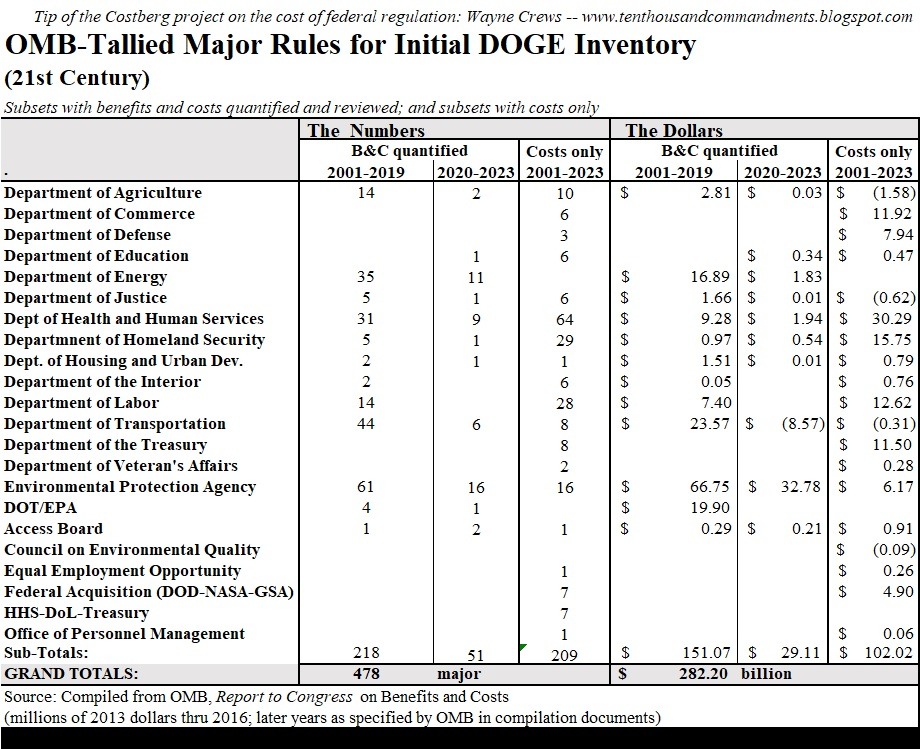DOGE’s first cut at bureaucracy: A target inventory

Donald Trump’s Executive Order 14219, “Ensuring Lawful Governance and Implementing the President’s ‘Department of Government Efficiency’ Regulatory Initiative,” has set the stage for a major regulatory rollback—even invoking “deconstruction.”
This directive, which formalizes Elon Musk’s “DOGE Team Leads” at agencies, aims at cutting unconstitutional and burdensome regulations while prioritizing efficiency and economic growth. The Department of Government Efficiency (DOGE) is likely to figure in a big way in Trump’s 2025 Address to Congress.
A more aggressive approach
Echoing Trump’s 2017 now largely forgotten regulatory reform Task Force efforts, EO 14219 takes a tougher stance, particularly when seen in conjunction with other recent orders setting up the one-in, ten-out agenda, bringing independent agencies under centralized White House regulatory review, and siccing DOGE on grants and contracts and the regulatory laundering they can facilitate.
Rather than simply reducing rules with excessive costs as regulatory orders have done traditionally, EO 14219 more explicitly targets regulations deemed unconstitutional, illegal power grabs, or obstructions to economic progress in ways that question legitimacy of the administrative state as such. Criteria for rule termination and modification align with recent Supreme Court rulings curtailing administrative overreach, positioning the executive branch for legal confrontations to challenge federal bureaucracy in almost unprecedented ways.
Prioritizing major rules
Trump’s order directs agencies to review “significant regulatory actions,” most often defined as those with economic effects of $100 million or more annually, but broader. Within 60 days, agencies must submit lists of regulations for rescission or modification, with the aim of incorporating systematic rollback proposals in the Spring Unified Agenda of regulations.
The chart below provides a quick overview of a major rule inventory for Trump to get started. Since 2001, OMB has identified 478 major rules imposing costs of up to $282 billion annually.

In a new article at Forbes, links to these rules and their Regulation Identifier Number are provided for DOGE deep-dives.
Tip of the costberg
The aforementioned tally is just the tip of the costberg, however—a Quick Start Guide, if you will.
Thousands of other regulations remain unquantified, and independent agencies like the FCC and SEC, traditionally exempt from oversight, are now within DOGE’s scope. Sub-regulatory guidance documents will also need to be addressed. “Significant regulatory actions” do not capture the sweep of the administrative state and its burdens.
To cement these reforms, the administration needs legislative backup to make DOGE reforms stick, especially since DOGE is working on an “America 250” deadline. The most important step needed to make streamlining permanent is to abolish departments and agencies, not just individual regulations. Short of that there are numerous other steps to take. The newest is Iowa Senator Joni Ernst’s (R-IA) proposed Searching for and Cutting Regulations that are Unnecessarily Burdensome (SCRUB) Act, which would institutionalize regulatory “Cut-Go” procedures, ensuring permanent oversight in the form of regulatory reviews. A more longstanding proposal is the Regulations from the Executive in Need of Scrutiny (REINS) Act would require congressional approval for certain significant rules.
The clock is ticking
With just over a year to execute these reforms, DOGE must act quickly. Executive actions alone are not enough—Congress must codify these efforts to prevent future administrations from reversing course. The opportunity to dismantle regulatory bloat is here—the match has been lit—but EO 14219’s “commence the deconstruction” will require aggressive action and legislative reinforcement to complete.
For more, see: “DOGE’s Quick Start Guide To Slashing Regulations,” Forbes